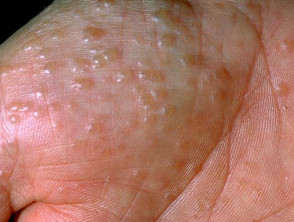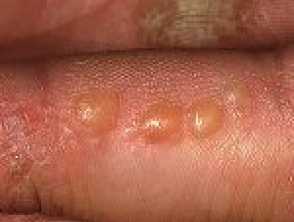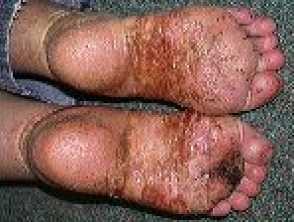What is dyshidrotic eczema?
Dyshidrotic eczema (pompholyx) is an itchy, chronic, recurrent, often symmetric eruption on the palms of hands, fingers, and soles of the feet. It is characterised by small, deep-seated, 1–2 mm fluid-filled vesicles on these sites, which resolve after several weeks with scaling.
Debate exists around precise terminology and definitions but other names for this condition include pompholyx, acute and recurrent vesicular hand dermatitis, acute palmoplantar eczema, vesicular endogenous eczema, cheiropompholyx (affecting the hands), podopompholyx or pedopompholyx (affecting the feet), and cheiropodopompholyx.
Who gets dyshidrotic eczema?
The prevalence of dyshidrotic eczema (pompholyx) is not known, but it is uncommon. Approximately 20% of patients assessed in a patch test clinic for hand dermatitis had dyshidrotic eczema (pompholyx). Occurrence appears not to correlate with age or gender.
What causes dyshidrotic eczema?
The cause of dyshidrotic eczema (pompholyx) is not known.
It is not related to occlusion of sweat glands as was first thought when the disease was recognised over 100 years ago, but there are some factors associated with the disorder, including:
- Atopy — the evidence is mixed with some reporting it as a risk and others not
- Contact dermatitis:
- Allergic contact dermatitis to a variety of antigens including nickel, chromium, and cobalt
- Irritant contact dermatitis may exacerbate the condition.
- Fungal infection — Tinea pedis can be associated with a dyshidrotic-like eruption
- Photoinduction — associated with ultraviolet A exposure
- Immunoglobulin therapy
- Hyperhidrosis — excessive sweating is an aggravating factor
- Other factors:
- Seasonal variation can also aggravate a recurrence
- Smoking
- Oral contraceptive pill
- Aspirin.
What are the clinical features of dyshidrotic eczema?
Dyshidrotic eczema (pompholyx) is a chronic, recurrent condition and appears as small, deep-seated, fluid-filled blisters (vesicles) on the sides of the fingers, hands, and feet.
- The vesicles are small (1–2mm), often symmetrical, with no associated erythema, and they do not occur elsewhere on the body. Vesicles may coalesce into larger blisters.
- It is extremely itchy.
- The vesicles commonly resolve after 2–3 weeks with peeling.
Vesicles can also occur in other types of hand dermatitis.
How do clinical features vary in differing types of skin?
Dyshidrotic eczema (pompholyx) is described as ‘tapioca-like’ in darker skin types, emphasising the greater colour contrast of the vesicles compared to less pigmented skin.
What are the complications of dyshidrotic eczema?
Dyshidrotic eczema (pompholyx) can lead to:
- Secondary infection, eg, bacterial infection with Staphylococcus aureus or Streptococcus pyogenes producing lymphangitis and cellulitis
- Paronychia and nail dystrophy if adjacent or proximal to the nail fold
- Physical and psychological disability; potential economic cost due to loss of work opportunity.
How is dyshidrotic eczema diagnosed?
It is a clinical diagnosis as the history and clinical appearances are typical when other causes are excluded.
- Unilateral involvement is suspicious for a fungal infection (eg, tinea manuum or tinea pedis), and skin scrapings should be taken for mycology.
- Patch testing may be considered in chronic or atypical cases where there is a suspicion of an allergic contact cause.
- Skin biopsy is rarely necessary, and shows a spongiotic eczema.
What is the differential diagnosis for dyshidrotic eczema?
Differential diagnosis includes the following skin conditions:
- Palmoplantar pustular psoriasis
- Contact dermatitis (irritant or allergic)
- Tinea (manuum and pedis)
- Scabies
- Bullous pemphigoid.
What is the treatment for dyshidrotic eczema?
General measures
- Avoid aggravating factors where possible.
- Potassium permanganate soaks may be useful in the acute phase.
Specific measures
- Topical treatments:
- topical steroids (usually potent or ultrapotent)
- Pimecrolimus and tacrolimus
- Bexarotene gel
- Regular use of emollients and moisturisers
- Iontophoresis or botulinum toxin when used for hyperhidrosis
- Topical antifungal medication if indicated for documented fungal infection.
- Phototherapy:
- Topical psoralens and ultraviolet light A (tPUVA).
- Systemic treatments:
- Antihistamines
- A short course of oral corticosteroids for immediate relief
- Oral antibiotics or antifungal agents if indicated for secondary skin infection
- Second-line agents include methotrexate, ciclosporin, azathioprine, and mycophenolate
- Oral retinoids including alitretinoin, acitretin, and isotretinoin
- Biologic agents including dupilumab.
What is the outcome for dyshidrotic eczema?
The disorder can be chronic and cyclic. Short-term or long-term second-line treatment may be needed depending on the behaviour of the disease. However, for many the disorder settles in time and treatments can be withdrawn.


